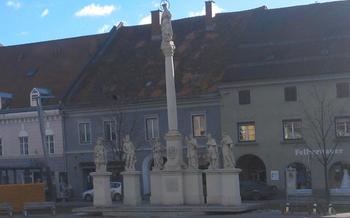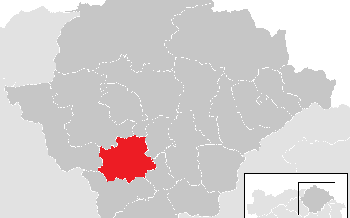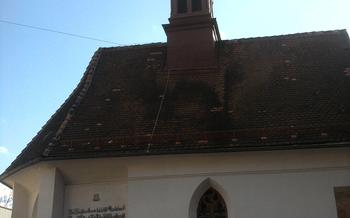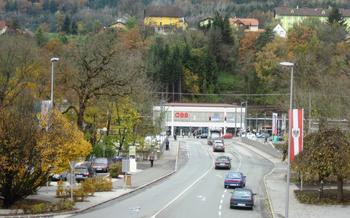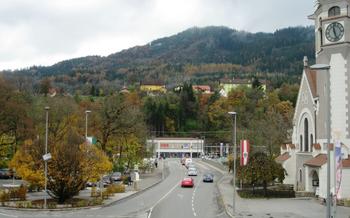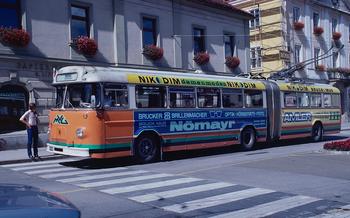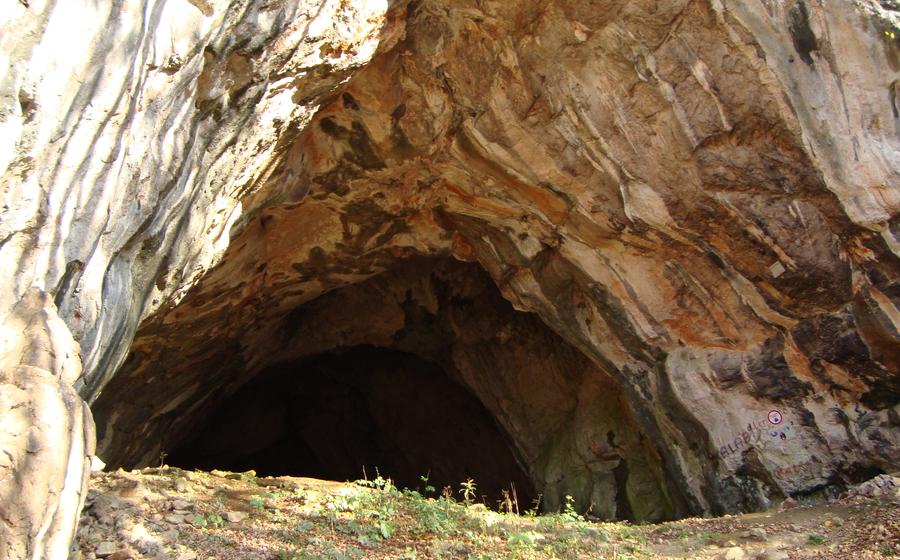
Drachenhöhle (Dragon's Cave) in Mixnitz
- Bruck an der Mur: A Town Steeped in History and Natural Beauty
- Drachenhöhle (Dragon's Cave): A Mystical Underground Realm
- Exploring the Cave: A Journey into the Unknown
- The Dragon's Lair: Unveiling the Mystery
- Navigating the Cave's Intricate Passages
- Witnessing Nature's Masterpiece: The Cave's Formations
- Unraveling the Secrets of the Underground River
- A Sanctuary for Wildlife: The Cave's Inhabitants
- History and Archaeology: Uncovering the Cave's Past
- The Dragon's Cave Museum: A Treasure Trove of Knowledge
- Practical Information for Visitors: Planning Your Trip
- Transportation and Accessibility: Getting to the Cave
- Accommodation and Dining Options: Where to Stay and Eat
- Local Festivals and Events: Immerse in Bruck's Culture
- Insider Tip: Capture the Magic of the Cave
Bruck an der Mur: A Town Steeped in History and Natural Beauty
Bruck an der Mur, a picturesque town nestled in the heart of Styria, Austria, boasts a rich historical legacy and an abundance of natural wonders. Located at the confluence of the Mur and Mürz rivers, Bruck an der Mur has served as a significant trading hub since the Middle Ages. Its strategic location on the crossroads of important trade routes contributed to its prosperity and cultural diversity.
The town's historical significance is evident in its well-preserved medieval architecture, including the imposing Landskron Castle, which stands majestically overlooking the town. Bruck an der Mur is also renowned for its natural beauty, surrounded by the stunning landscapes of the Hochschwab Mountains and the Mürztal Alps. These majestic peaks, lush forests, and crystal-clear lakes offer a haven for outdoor enthusiasts, providing ample opportunities for hiking, biking, and various adventure activities.
Bruck an der Mur's cultural heritage is equally diverse and vibrant. The town is home to several museums, galleries, and cultural institutions that showcase its rich history, art, and traditions. Visitors can delve into the region's fascinating past at the Bruck an der Mur Museum, admire contemporary art exhibitions at the Künstlerhaus, or experience traditional Styrian music and dance performances at the Volkshaus.
Drachenhöhle (Dragon's Cave): A Mystical Underground Realm
Nestled in the heart of Mixnitz, a picturesque village in Austria, lies the Drachenhöhle, an awe-inspiring natural wonder that has captivated visitors for centuries. Steeped in ancient legends and myths, the cave is an enchanting labyrinth of underground chambers and passages, inviting explorers to uncover its secrets.
The geological history of the Drachenhöhle dates back millions of years, shaped by the relentless forces of water and time. Its limestone formations, honed by the erosive power of an underground river, have given rise to an array of magnificent stalactites and stalagmites, creating an otherworldly landscape that seems frozen in time.
The cave's name, meaning "Dragon's Cave," is derived from the mythical creatures that are said to have once roamed its depths. Legends abound, weaving tales of fierce dragons guarding the cave's hidden treasures and protecting its subterranean realm.
As a natural landmark of exceptional beauty and significance, the Drachenhöhle stands as a testament to the wonders of the natural world. Recognized for its geological formations, historical importance, and cultural heritage, the cave attracts visitors from around the globe, eager to delve into its mysterious depths and experience its captivating allure.
Exploring the Cave: A Journey into the Unknown
For an adventurous and immersive experience, visitors can embark on a guided tour of the Drachenhöhle. These tours are led by knowledgeable and experienced guides who provide insights into the cave's history, geology, and legends. The tours are designed to cater to visitors of all ages and fitness levels, ensuring a safe and enjoyable exploration.
The duration of the cave tour typically ranges from one to two hours, depending on the chosen route and the group's pace. During the tour, visitors will navigate through the cave's intricate passages, marveling at the stunning rock formations and experiencing the unique atmosphere of the underground world.
Along the way, guides will point out notable features of the cave, such as impressive stalactites and stalagmites, as well as other geological formations that have been shaped by centuries of water erosion. Visitors will also learn about the cave's unique ecosystem and the diverse wildlife that inhabits it.
Whether you are a nature enthusiast, a history buff, or simply seeking an unforgettable adventure, a guided tour of the Drachenhöhle promises a captivating and enriching experience.
The Dragon's Lair: Unveiling the Mystery
The dragon, a mythical creature deeply entwined with the history and culture of the region, holds a significant place in the legends surrounding the Drachenhöhle. According to local folklore, the cave served as the lair of a fearsome dragon that terrorized the surrounding lands. This dragon, with its fiery breath and sharp claws, was said to have guarded a hoard of treasure within the cave's hidden chambers.
The dragon motif, deeply embedded in the cultural heritage of the region, symbolizes strength, power, and mystery. It represents the untamed forces of nature and the unknown that lies beneath the surface. The connection between the Drachenhöhle and dragon mythology further enhances the cave's mystique, inviting visitors to step into a realm where fantasy and reality intertwine.
Within the cave, one can find symbolic representations of the dragon in various forms. Stalactites and stalagmites, shaped by the relentless dripping of water over millennia, resemble the dragon's teeth and claws, creating an eerie and captivating atmosphere. These natural sculptures serve as a testament to the cave's rich history and the enduring power of legends.
Navigating the Cave's Intricate Passages
Exploring the Drachenhöhle requires caution and preparation. Guided tours are mandatory, led by experienced guides who ensure visitor safety and provide insights into the cave's history and geology. The cave's terrain can be uneven, with slippery surfaces and narrow passages, so sturdy footwear with good traction is essential. Comfortable clothing that allows for freedom of movement is recommended, as you may need to crawl or stoop in some areas.
Before embarking on the tour, visitors are provided with helmets and flashlights to navigate the cave's dimly lit chambers. The guides will instruct you on safety procedures and techniques for safe exploration. Be prepared for low temperatures and high humidity inside the cave, so consider bringing a light jacket or sweater.
Respecting the cave's fragile ecosystem is crucial. Avoid touching or disturbing the cave formations, as they are delicate and can take thousands of years to form. Stay on designated paths and follow the guide's instructions to prevent any damage to the cave's natural beauty.
Witnessing Nature's Masterpiece: The Cave's Formations
The Drachenhöhle is renowned for its magnificent and diverse cave formations, which are the result of millions of years of water erosion and mineral deposition. Stalactites, which hang from the ceiling, and stalagmites, which rise from the floor, create a surreal and awe-inspiring landscape. These formations come in various shapes and sizes, resembling frozen waterfalls, chandeliers, and even mythical creatures.
The process of formation begins with water seeping into the cave through cracks and fissures in the rock. As the water trickles through, it dissolves minerals such as calcium carbonate. When the water droplets reach the cave's ceiling, they evaporate, leaving behind a tiny deposit of minerals. Over time, these deposits accumulate, forming stalactites. Water dripping from the stalactites then creates stalagmites on the floor below.
The cave's formations are not only visually stunning but also scientifically significant. They provide valuable insights into the geological history of the region and the processes that have shaped the cave over millions of years. Conservation efforts are in place to protect these delicate formations and ensure their preservation for future generations.
Unraveling the Secrets of the Underground River
Beneath the surface of Drachenhöhle lies a hidden gem – an underground river that meanders through the cave's labyrinthine passages, adding an extra layer of wonder to this subterranean realm. This natural watercourse has played a pivotal role in shaping the cave's intricate formations over millions of years.
The underground river, fed by rainwater and snowmelt, has relentlessly carved its way through the limestone, leaving behind a mesmerizing display of natural artistry. The water's erosive power has sculpted smooth channels, formed deep pools, and created breathtaking waterfalls, echoing through the cave's chambers.
Beyond its aesthetic allure, the underground river holds significant scientific value. It serves as a vital habitat for diverse aquatic creatures that have adapted to the unique conditions of this subterranean world. The river's ecosystem supports a variety of species, including blind cave fish, salamanders, and various invertebrates, each playing a crucial role in maintaining the delicate balance of this fragile environment.
Conservation efforts are paramount to preserving the pristine beauty and ecological integrity of the underground river. Visitors are encouraged to respect the cave's delicate ecosystem by avoiding any actions that could pollute or disturb the water. By working together, we can ensure that this subterranean wonder remains a source of awe and inspiration for generations to come.
A Sanctuary for Wildlife: The Cave's Inhabitants
The Drachenhöhle is home to a diverse array of wildlife that has adapted to the unique conditions of the cave environment. Among the most notable inhabitants are bats, which play a crucial role in the cave's ecosystem. These fascinating creatures navigate the darkness with their echolocation abilities, hunting for insects and other small prey. Their presence contributes to the cave's biodiversity and adds to its mystique.
Bats are not the only creatures that call the Drachenhöhle home. Other cave-dwelling species include spiders, beetles, and salamanders, each with its own unique adaptations for surviving in the dark and humid environment. These creatures form an intricate web of life within the cave, contributing to its ecological balance.
Protecting the cave's wildlife is essential for maintaining the delicate equilibrium of the ecosystem. Conservation efforts focus on preserving the cave's natural environment and minimizing human disturbance. Visitors are encouraged to respect the wildlife and refrain from touching or disturbing the animals. By doing so, we can ensure that the Drachenhöhle remains a haven for these unique creatures for generations to come.
History and Archaeology: Uncovering the Cave's Past
The Drachenhöhle has served as a sanctuary and shelter for humans throughout history. Archaeological excavations have revealed evidence of prehistoric settlements within the cave, including tools, pottery, and other artifacts. These discoveries suggest that the cave was inhabited by humans as early as the Stone Age.
In addition to its prehistoric significance, the cave also holds historical importance as a medieval hideout. During the turbulent Middle Ages, the cave provided refuge for local villagers seeking protection from invading armies and bandits. The cave's intricate passages and hidden chambers offered a safe haven for those seeking shelter from danger.
Over the centuries, the Drachenhöhle has attracted the attention of scholars and historians eager to unravel its secrets. Archaeological expeditions have unearthed a wealth of artifacts, including coins, jewelry, and weapons, providing valuable insights into the lives of those who once sought refuge within the cave.
Ongoing research and exploration continue to shed light on the cave's rich history. Archaeologists are working to piece together the puzzle of the cave's past, uncovering new evidence that helps us understand the role it played in the lives of our ancestors.
The Dragon's Cave Museum: A Treasure Trove of Knowledge
Complementing your awe-inspiring encounter with the Drachenhöhle, make sure to visit the Dragon's Cave Museum, a treasure trove of knowledge that delves deep into the cave's captivating history, geological wonders, and legendary tales. Conveniently located near the cave entrance, the museum offers a comprehensive and interactive journey through the cave's past and present.
Within the museum's walls, you'll discover a wealth of exhibits and displays that bring the cave's story to life. Learn about the geological processes that shaped this subterranean marvel, from the formation of its intricate stalactites and stalagmites to the role of the underground river in carving out its chambers. Immerse yourself in the fascinating legends and myths that have surrounded the cave for centuries, including the captivating tale of the dragon that gives the cave its name.
The Dragon's Cave Museum offers a truly immersive experience with interactive exhibits that allow you to engage with the cave's history and science in a hands-on way. Touchscreen displays, multimedia presentations, and life-size replicas bring the cave's wonders to life, making learning an interactive and enjoyable experience for visitors of all ages.
This remarkable museum serves as a testament to the significance of the Drachenhöhle, preserving and sharing its rich heritage with the world. It's a must-visit destination for anyone seeking to delve deeper into the mysteries and marvels of this enchanting cave.
Practical Information for Visitors: Planning Your Trip
Before embarking on your journey to the Drachenhöhle, it's essential to plan your visit to ensure a smooth and enjoyable experience. Here are some practical tips:
-
Getting in Touch: For general inquiries, contact information, and reservations, you can visit the Drachenhöhle's official website. It provides up-to-date information, including opening hours, admission fees, and guided tour schedules.
-
Admission Fees: To explore the Dragon's Cave, you'll need to purchase an admission ticket. Prices vary depending on the type of ticket (adult, child, student, etc.) and whether you opt for a guided tour or self-guided exploration.
-
Guided Tours: Guided tours are highly recommended for a comprehensive and informative experience. They are led by knowledgeable guides who share insights about the cave's history, geology, and legends. Tours are available in various languages and must be booked in advance.
-
Facilities and Amenities: The Drachenhöhle is well-equipped with facilities to ensure a comfortable and safe visit. There's ample parking space for visitors arriving by car. Restrooms are available on-site, and there's a small cafe where you can grab a snack or a refreshing drink before or after your cave exploration.
Transportation and Accessibility: Getting to the Cave
Reaching the Drachenhöhle is a breeze, regardless of your preferred mode of transportation. For those who love the freedom of self-exploration, the cave is easily accessible by car. Simply follow the picturesque roads leading from major cities in Austria, and you'll find yourself at the cave's doorstep. If public transportation is more your style, hop aboard a train or bus bound for Mixnitz. Once there, a short and scenic walk will bring you to the cave's entrance. And for those with limited mobility or special needs, fear not, as the Drachenhöhle is fully accessible, ensuring a hassle-free and enjoyable visit for all.
And once you've arrived, don't forget to take advantage of the ample parking facilities near the cave entrance. Leave your vehicle in safe hands and embark on your subterranean adventure without a worry. Whether you're driving, taking public transport, or have specific accessibility requirements, the Drachenhöhle is ready to welcome you with open arms.
Accommodation and Dining Options: Where to Stay and Eat
For a comfortable stay near the Drachenhöhle, you'll find a range of accommodation options catering to various budgets and preferences. Choose from cozy guesthouses offering traditional Austrian hospitality to modern hotels providing contemporary amenities. Whether you prefer the charm of a family-run inn or the convenience of a centrally located hotel, you'll find suitable options in Bruck an der Mur and its surroundings.
To savor the flavors of the region, indulge in local cuisine at one of the many restaurants in the area. Sample traditional Austrian dishes prepared with fresh, seasonal ingredients, accompanied by a glass of local wine or beer. From hearty stews to delicate pastries, the culinary delights of Bruck an der Mur will tantalize your taste buds.
For a more immersive experience, consider packing a picnic lunch and enjoying it in one of the designated picnic areas near the cave. Surrounded by picturesque landscapes, you can relish your meal while basking in the tranquil ambiance of nature.
Don't miss the opportunity to try local specialties like "Steirerkrapfen," a savory filled pasta, or "Kürbiskernöl," a flavorful pumpkin seed oil. These culinary treasures are a testament to the region's rich gastronomic heritage.
Local Festivals and Events: Immerse in Bruck's Culture
Bruck an der Mur is a vibrant town that celebrates its rich cultural heritage through a variety of festivals and events throughout the year. These events offer an immersive experience for visitors to delve into the local traditions and customs. One of the most notable events is the annual Brucker Adventmarkt, a charming Christmas market held in the historic town square. Visitors can enjoy festive stalls selling handmade crafts, local delicacies, and mulled wine, creating a magical ambiance that captures the spirit of the season.
Another highlight is the Brucker Sommerfest, a summer festival that celebrates the town's history and natural beauty. The festival features live music, traditional dances, and culinary delights from the region. Visitors can also participate in outdoor activities such as hiking, biking, and swimming in the nearby lakes.
For those interested in the town's industrial heritage, the Brucker Eisenfest is a must-visit. This festival showcases the town's ironworking traditions and features demonstrations of traditional iron forging techniques. Visitors can also explore the town's Iron Museum to learn more about its industrial past.
By attending these local festivals and events, visitors can gain a deeper understanding of Bruck an der Mur's unique culture and create lasting memories of their time in this charming town.
Insider Tip: Capture the Magic of the Cave
The Drachenhöhle offers a photographer's paradise, with its stunning formations and atmospheric lighting. To capture the magic of the cave, consider bringing a sturdy tripod to ensure sharp images. A wide-angle lens will allow you to capture the vastness of the cave's chambers, while a macro lens will help you focus on the intricate details of the stalactites and stalagmites. Experiment with different shutter speeds to capture the movement of the underground river or create ethereal light trails. Remember to use a low ISO to minimize noise and maintain image quality. Respect the cave's environment by using natural light sources whenever possible and avoiding disturbing the wildlife. Your efforts will be rewarded with breathtaking images that will serve as lasting mementos of your subterranean adventure.
